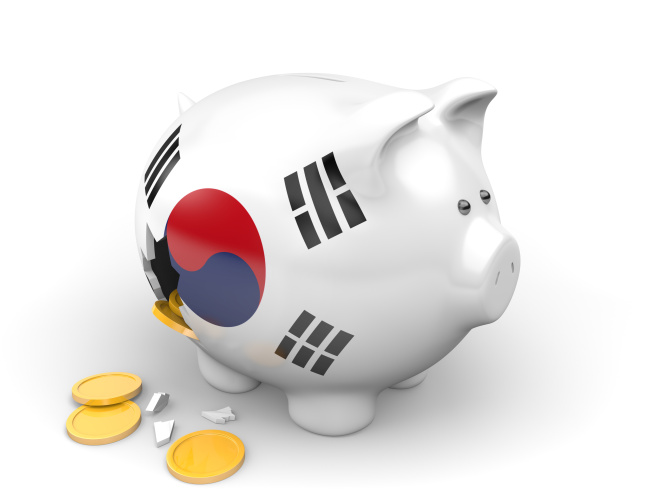South Korea's per capita GDP to exceed $30,000 in 2018: data
By Korea HeraldPublished : Aug. 6, 2017 - 17:39
South Korea’s per capita gross domestic product is expected to exceed $30,000 in 2018, raising its global ranking by two steps, the government predicted based on data.
According to data released Sunday by the International Monetary Fund on 190 countries, South Korea’s per capita GDP stood at $27,633 as of October 2016. The Ministry of Strategy and Finance claimed that the figure will reach $29,200 this year and rise up to $30,353 in the following year.
Should the prediction be met, the nation is likely to edge past Italy which reached $30,294 per capita GDP last year but is still faced with a slow growth --in January the IMF lowered this year’s growth forecast for the European state from 0.9 percent to 0.7 percent.
According to data released Sunday by the International Monetary Fund on 190 countries, South Korea’s per capita GDP stood at $27,633 as of October 2016. The Ministry of Strategy and Finance claimed that the figure will reach $29,200 this year and rise up to $30,353 in the following year.
Should the prediction be met, the nation is likely to edge past Italy which reached $30,294 per capita GDP last year but is still faced with a slow growth --in January the IMF lowered this year’s growth forecast for the European state from 0.9 percent to 0.7 percent.

Among 12 states which recorded a per capita GDP of $50,000 or more, Luxemburg topped the list with $105,829 as the only player making it above the $100,000 mark, followed by Switzerland with $79,578 and Norway with $71,497.
In the $30,000 range were six countries -- France, New Zealand, United Arab Emirates, Japan, Israel, and Italy -- while Puerto Rico, South Korea, Spain and Kuwait remained in the $26,000-29,999 cluster, vying to rise above the $30,000 mark.
The $30,000 line is considered a milestone in per capita GDP as all of the Group of Seven industrialized countries remain above the amount.
Should the government prediction turn out true, South Korea will reach this reference line in 12 years since its per capita GDP first surpassed the $20,000 mark, which is relatively slow compared to the global average.
According to the National Assembly’s Budget Office data, the average period it takes a state to up its per capita GDP from $20,000 to $30,000 is 8.2 years. The analysis excluded countries with special circumstances such as oil production and an exceptionally small-sized economy.
Switzerland made the leap in just two years, while France and Canada took longer than 12 years.
Italy joined the $30,000 cluster in 2004, nine years after it reached the $20,000 mark in 1995, but dropped back into the $20,000 range in 2015.
Despite the government’s optimistic forecast, concerns persist that the rise in per capita GDP may be held back by disappointing economic growth or a weak Korean won.
The ministry’s figures are based on the assumption that the growth rate for this year and next year will be 3 percent, making a progress from the 2 percent range growth rate in 2015 and 2016.
The Moon Jae-in administration, which kicked off in May this year, has vowed to pull off sustainable growth forward by boosting exports and domestic consumption under the slogan of “income-led growth.”
The vision, however, faces challenges such as weak production, low birth rates and an ageing society, and the persisting slow growth of the global economy.
Another risk is the plausibility that the pace of the US benchmark interest rate may weaken the Korean won as early as within the year or by the first half of next year.
South Korea saw an increase in its won-based GDP in 2007-2009 but its dollar-based per capita GDP fell during this period due to the drop in exchange rate.
By Bae Hyun-jung (tellme@heraldcorp.com)
-
Articles by Korea Herald


![[AtoZ into Korean mind] Humor in Korea: Navigating the line between what's funny and not](http://res.heraldm.com/phpwas/restmb_idxmake.php?idx=644&simg=/content/image/2024/04/22/20240422050642_0.jpg&u=)
![[Exclusive] Korean military set to ban iPhones over 'security' concerns](http://res.heraldm.com/phpwas/restmb_idxmake.php?idx=644&simg=/content/image/2024/04/23/20240423050599_0.jpg&u=20240423183955)


![[Herald Interview] Why Toss invited hackers to penetrate its system](http://res.heraldm.com/phpwas/restmb_idxmake.php?idx=644&simg=/content/image/2024/04/22/20240422050569_0.jpg&u=20240422150649)
![[Graphic News] 77% of young Koreans still financially dependent](http://res.heraldm.com/phpwas/restmb_idxmake.php?idx=644&simg=/content/image/2024/04/22/20240422050762_0.gif&u=)







![[Exclusive] Korean military to ban iPhones over security issues](http://res.heraldm.com/phpwas/restmb_idxmake.php?idx=652&simg=/content/image/2024/04/23/20240423050599_0.jpg&u=20240423183955)



![[Today’s K-pop] Ateez confirms US tour details](http://res.heraldm.com/phpwas/restmb_idxmake.php?idx=642&simg=/content/image/2024/04/23/20240423050700_0.jpg&u=)